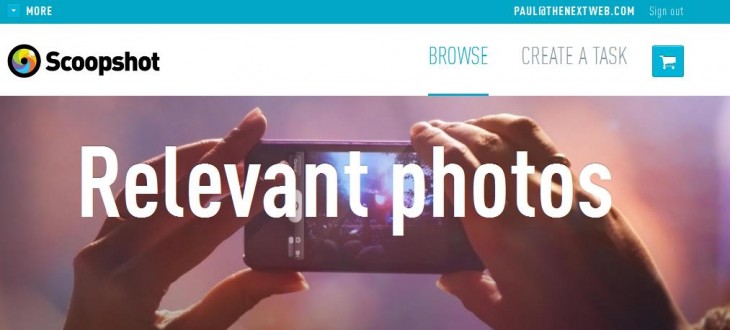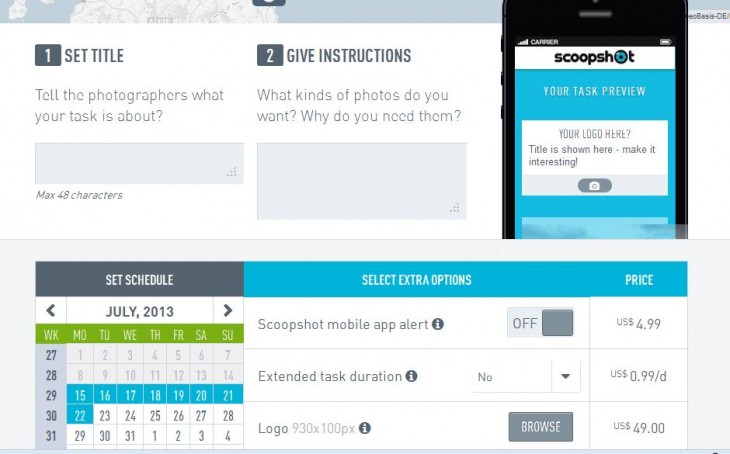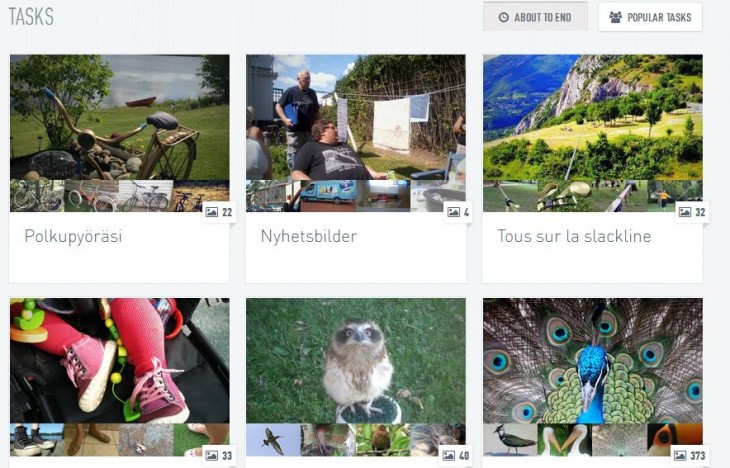
While ‘crowdsourcing’ as a descriptive nomenclature has become a hackneyed term in recent times, the fact is there is no better word to describe a venture that taps the power of the people to deliver its service.
Launched in 2010, Scoopshot is a photo crowdsourcing service that seeks to connect both amateur (mobile) and professional photographers with media companies and other photo-buying bodies. And today, the company is announcing a $1.2m funding round as it officially lifts the lid on the all-new version of the platform – so we thought we’d take a quick peek to see what’s under the hood.
Scoopshot: What’s the scoop?
Thus far, Scoopshot’s service has pretty much been behind closed doors – buyers would log-in via Scoopshot’s website to set photo tasks or review photos that had been submitted by mobile photographers. With the all-new Scoopshot, however, everyone can now browse live photo tasks and set tasks directly from the homepage.

Though the new service has actually been live since June, only those who have downloaded the Android or iPhone app have been able to create an account. From today, this opens to everyone.
The mobile app is still essentially the photographer’s main tool – this is where they can upload and manage their snaps from, as well as browse current tasks that have been set.
The Web-based portal is where anyone can now create tasks, as well as browse existing tasks.
In terms of creating a task, you can choose to do a manual search by a very localized area which covers a 20km region, or by ‘National’ (country) or Global. You can also drag the pin to any point on the map.

You’ll see how many photographers are based in your chosen vicinity which will help determine how likely your project will be to get off the ground. If there isn’t a Scoopshot user in the region, well, chances are you’ll need to explore other options.

You then set a title for your project (e.g. ‘Oxford Street Traffic’), basic instructions of what it should encapsulate, a schedule and you’re more or less good to go.

Costs
Now, there are other options you can set which bump up the cost of the service for the creator.
Local tasks are free, but if you want to enable mobile alerts via push notifications, this will set you back $4.99. National tasks only cost $0.90, but if you want Scoopshot photographers to be notified, you’ll need to fork out $9; and global tasks cost $49 but come attached with a chunky $499 mobile alert price-tag.
Other add-ons at the checkout include the ability to extend the task, a company logo and a task banner for the Web. These all vary in price depending on whether you’re local, national or global.
It’s worth adding here that the task-creator actually pays for the task when setting it – so depending on what plan you opt for, you could be spending a lot of money with no guarantee of anyone taking you up on the task, or of there being any quality snaps.
Prices are set at $5 for each photo on the website – and anyone can buy them, not just the task-creator. Indeed, the task-creator may not buy a photo at all, and isn’t compelled to do so. However, for each photo that is sold, the photographer receives $2.50.
Browsing
For those looking to browse tasks through the Web app, you can do so by ones that are ‘About to End’, or by popularity.

This would really benefit from a better task-filtering system, as things stand you can’t really browse by location, and it would be good to be able to filter by topics too – for example if you have a penchant for taking photos of food. On this front, we’re told that sorting and search will be given ‘top priority’ in forthcoming updates.
It would also benefit greatly from being able to filter out tasks that have ended from ones that are still ongoing. As things stand, when you’re in the ‘About to End’ section, this also includes expired tasks – so there’s no real obvious way of knowing which are still ‘open’ and which aren’t.
Show me the money
As noted already, Scoopshot is also announcing a $1.2m funding round to help it take-on more established stock photo sites.
The funds come from Yuri Arcurs, who has made a pretty good living as a microstock photogpher – he sells one photo every eight seconds, apparently. And we’re told the cash bounty will be used to grow its international presence in the UK, US and Germany.
“Crowdsourcing offers the unique opportunity to gain both, while adding the element of engagement to the photo sourcing process itself” says Petri Rahja, founder and COO of Scoopshot. “With Scoopshot you can crowdsource images, run photo competitions, do content marketing, gain consumer insights and much more. Your imagination is the only limiting factor.”
But Scoopshot is looking beyond being just another player in the industry, and CEO Niko Ruokosuo reckons what they’re doing could disrupt the whole stock photo industry.
“Buyers are tired of wading through page after page of stale and over-used photography, before having to compromise,” he says.
“For the first time, they can request exactly what they want and receive it within minutes and without spending a fortune,” he continues. “The birth of on-demand photography will be as much of a game changer for the photo industry as iTunes for the Music industry. It is our belief that the majority of stock photography will be on-demand within the next five years. To survive, photo sites must adapt and adopt new models for monetizing photography. It really is a case of do or die.”
The one thing I’d say about this model, however, is that Scoopshot relies on mobile phones to take photos. Traditional stock image sites typically use professional-grade equipment, and this will undoubtedly be reflected in the end product.
Though ‘mobile’ is a core underlying tenet of Scoopshot, an option to include uploads via the browser would certainly open things up to better-quality images. Again, this is something we’re told will be integrated in future updates – and I think it will be far better for it. If you’re potentially paying upwards of $500 for a task, you at least want a guarantee that the recipient is using a semi-decent DSLR as opposed to an iPhone.
There is a separate service aimed specifically at the media though – back in December last year, Scoopshot launched a PRO offering, where photo assignments can be given to accredited freelance photographers.
Operating in 177 countries, Scoopshot has drawn in around 280,000 mobile photographers and 1,300 professional photographers from around the world.
The new Scoopshot is open for anyone to create tasks now.
Feature Image Credit – Thinkstock
Get the TNW newsletter
Get the most important tech news in your inbox each week.





